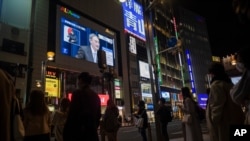Japanese Prime Minister Yoshihide Suga Thursday announced that Tokyo’s month-long COVID-19 state of emergency will be lifted Monday, citing reduced overall infection numbers since January, and hospital occupancy.
Speaking to reporters at a news conference, Suga said the number of infections in Tokyo and three surrounding prefectures has dropped by more than 80 percent since early January. He said Tokyo’s new daily cases once numbered 2,520, but the number stood as 323 as of Thursday.
He said, “We set around 500 daily cases as a threshold for lifting the state of emergency and Tokyo has kept infection cases lower than that for 40 consecutive days."
The state of emergency basically affected bars and restaurants, forcing them to close by 8 p.m. local time. Other businesses were asked to take preventive measures, including having employees work remotely. Similar emergency measures were lifted in six of Japan’s urban areas late last month.
Some officials have expressed concern that lifting the state of emergency will encourage the public to be less vigilant, resulting in a new spike in cases. Suga acknowledged that daily numbers had plateaued or crept up in some areas in recent days. He encouraged people to remain vigilant about new variant strains of the coronavirus responsible for the COVID-19 disease.
Health Minister Norihisa Tamura told The Japan Times following a meeting of the government COVID-19 advisory panel the government “must make sure the message to the public is not that our lives are back to normal just because the state of emergency is lifted.”
Tokyo and the three surrounding prefectures - Kanagawa, Chiba and Saitama, will ask restaurants to close by 9 p.m., at least until the end of March, to reduce the chance of a resurgence in infections.
Japan currently has seen more than 450,000 confirmed cases and 8,700 deaths, according to the Johns Hopkins University, which is tracking the global outbreak.
Japan Lifting Tokyo COVID-19 State of Emergency, Effective Monday
- By VOA News








